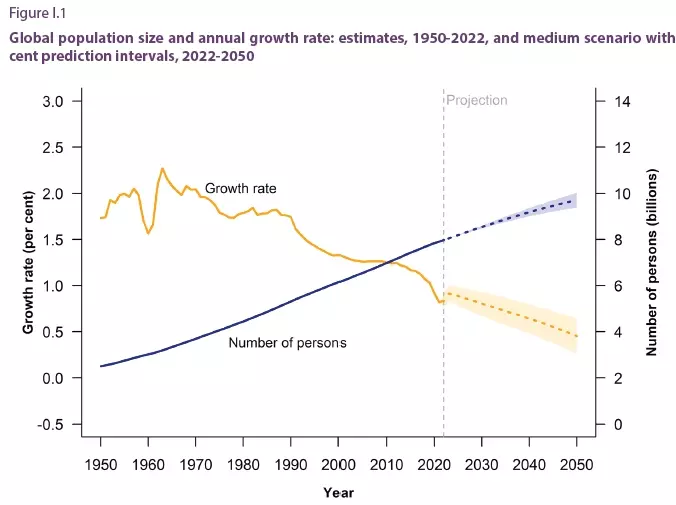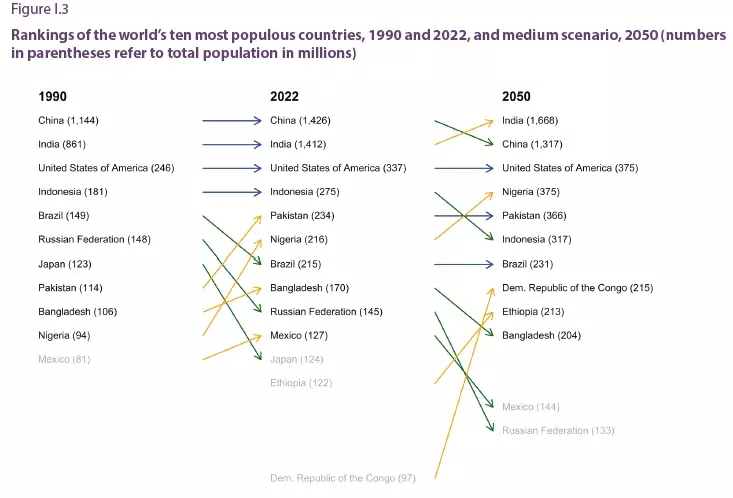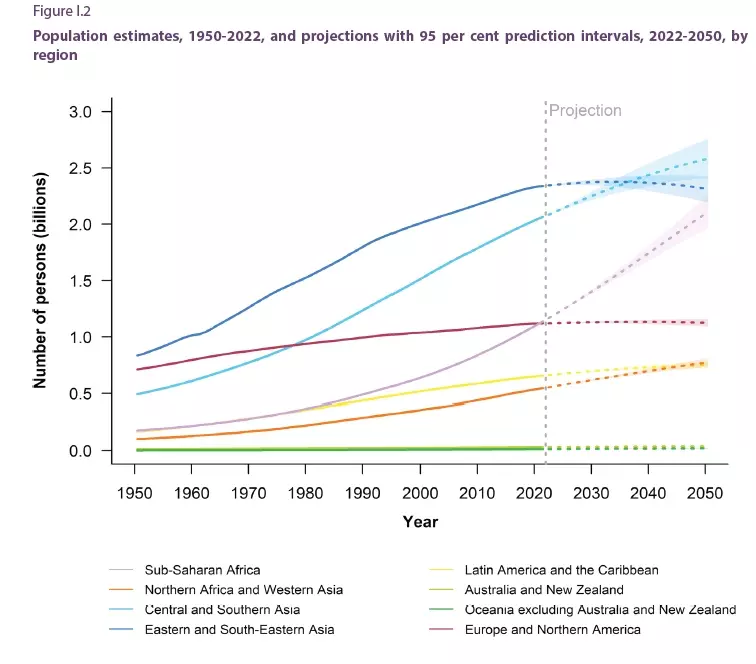Comments
- No comments found

Global population will surpass 8 billion in just a few weeks on November 15, 2022, according to projections from the United Nations in its World Population Prospects 2022.
I’m perhaps less concerned about global population growth than some commenters, because predictions about a population apocalypse have been around for a long time without coming true. But population changes do reflect underlying changes in life expectancy and birth rates in ways that shift age distributions and family patterns. In addition, shifts in where the global population lives will alter the shape of international politics in future decades.
Here’s the basic population pattern from the UN demographers from 1950 to 2050. Total population (blue line) is rising. It’s projected to top out at about 10.4 billion in the 2080s. The growth rate of the population (yellow line) has been falling to less than 1% annually, and heading lower.

The UN describes the underlying patterns of life expectancy and birth rates this way:
Population growth is caused in part by declining levels of mortality, as reflected in increased levels of life expectancy at birth. Globally, life expectancy reached 72.8 years in 2019, an increase of almost 9 years since 1990. Further reductions in mortality are projected to result in an average longevity of around 77.2 years globally in 2050. … In 2021, the average fertility of the world’s population stood at 2.3 births2 per woman over a lifetime, having fallen from about 5 births per woman in 1950. Global fertility is projected to decline further to 2.1 births per woman by 2050. … Given that most population increase until 2050 will be driven by the momentum of past growth, further actions by Governments aimed at reducing fertility would do little to slow the pace of growth between now and midcentury, beyond the gradual slowdown indicated by the projections presented here.
The increase in population is surely a matter for continued close attention, for economic, environmental and political reasons. But there have been prominent predictions of global overpopulation leading to mass famine for centuries now. Yes, predictions that have been wrong for centuries could still come true in the future. But before jumping to such conclusions, it’s worth taking a moment to acknowledge that the past predictions of overpopulation leading to a sharp degradation of living standards have been wrong, and to think about why.
For economists, the classic predictions of overpopulation are those of Thomas Robert Malthus in his 1798 Essay on the Principle of Population. Malthus argued that the growth of food supply happened in a linear way, while the growth of population happened in a geometric way. Thus, with population growing at a certain percentage rate each year, it would at some point spike upward beyond the food supply. Malthus didn’t provide a numerical estimate of the timing, but the general sense was that this shift was perhaps a few decades in the future. Global population was about 800 million when Malthus was writing, so the world population has grown 10-fold. The missing ingredient in Malthus’ reasoning was that food supplies–and in general economic growth–doesn’t need to happen in a linear way, but as a result of technological change it can also be geometric. There may be a race between the growth rates of population and food supply at certain times and places, but it is not a race that food supply is fated to lose.
A more recent example is Paul Erhlich’s 1968 best-seller The Population Bomb, which opened with the words: “The battle to feed all of humanity is over,” and predicted that hundreds of millions of people would starve to death in the 1970s and that the world death rate would rise substantially. Instead, it’s life expectancy that has risen substantially. And according to the World Bank, about 40% of the world population was below an international poverty line consumption level of $2.15 per day in 1985, but that share has now fallen to 8.4% by 2019. Like Malthus more than 150 years earlier, Ehrlich failed to appreciate the potential of technology–like the Green Revolution in agricultural technology–to expand food output.
Thus, while I know that a higher global population will raise difficult issues, the historical record strongly suggests that cries of looming catastrophe have been overdone. It also suggests that the ultimate answers may involve developing new technologies.
The growth of the global population is not evenly distributed around the world. Indeed, it will shake up some long-term patterns. Perhaps most notably, the UN predicts that India will become the world’s most populous country, outstripping China, next year. Here are some shifts in the world’s most-populous countries over time.

The rise in the population rankings of Nigeria, Ethiopia, and Dem. The Republic of the Congo by 2050 is part of a regional shift: the region of Africa will make up a larger share of the global population. We are used to a world where the regions of Asia (light blue and dark blue lines) are the largest by population. But population growth in those regions has slowed. By about 2050, the region of sub-Saharan Africa will have almost caught up in the total regional population. Thus, the issues of economic development for that region, and possibilities of out-migration from that region if development doesn’t take hold, are likely to loom especially large in the next few decades.

Timothy Taylor is an American economist. He is managing editor of the Journal of Economic Perspectives, a quarterly academic journal produced at Macalester College and published by the American Economic Association. Taylor received his Bachelor of Arts degree from Haverford College and a master's degree in economics from Stanford University. At Stanford, he was winner of the award for excellent teaching in a large class (more than 30 students) given by the Associated Students of Stanford University. At Minnesota, he was named a Distinguished Lecturer by the Department of Economics and voted Teacher of the Year by the master's degree students at the Hubert H. Humphrey Institute of Public Affairs. Taylor has been a guest speaker for groups of teachers of high school economics, visiting diplomats from eastern Europe, talk-radio shows, and community groups. From 1989 to 1997, Professor Taylor wrote an economics opinion column for the San Jose Mercury-News. He has published multiple lectures on economics through The Teaching Company. With Rudolph Penner and Isabel Sawhill, he is co-author of Updating America's Social Contract (2000), whose first chapter provided an early radical centrist perspective, "An Agenda for the Radical Middle". Taylor is also the author of The Instant Economist: Everything You Need to Know About How the Economy Works, published by the Penguin Group in 2012. The fourth edition of Taylor's Principles of Economics textbook was published by Textbook Media in 2017.
Leave your comments
Post comment as a guest